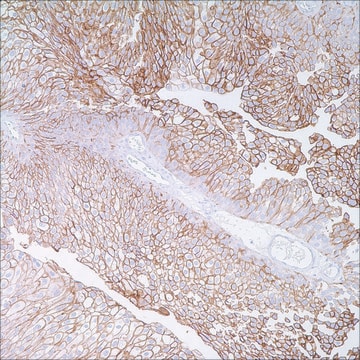SRP3172
Thrombomodulin human
recombinant, expressed in HEK 293 cells, ≥98% (SDS-PAGE), ≥98% (HPLC), suitable for cell culture
Synonym(s):
BDCA-3, CD141, THBD, TM
Sign Into View Organizational & Contract Pricing
All Photos(1)
About This Item
UNSPSC Code:
12352202
NACRES:
NA.32
Recommended Products
biological source
human
recombinant
expressed in HEK 293 cells
Assay
≥98% (HPLC)
≥98% (SDS-PAGE)
form
lyophilized
mol wt
51.4 kDa
packaging
pkg of 10 μg
technique(s)
cell culture | mammalian: suitable
impurities
<0.1 EU/μg endotoxin, tested
color
white
UniProt accession no.
shipped in
wet ice
storage temp.
−20°C
Gene Information
human ... THBD(7056)
General description
Thrombomodulin is an integral membrane protein that spans a length of 559 residues and contains five structural domains. The hydrophobic amino terminal domain is made up of 223 amino acid residues. The adjacent domain contains six EGF type B repeats spanning a length of 236 residues. This is followed by a 34 amino acid-long Ser/Thr-rich domain, which may be involved in 0-linked glycosylation. The next domain is a putative membrane-spanning domain of 23 residues, followed by a carboxyl-terminal cytosolic tail of 38 residues. The gene encoding this protein lacks introns. Recombinant soluble thrombomodulin is a 491 amino acid glycoprotein containing the extracellular domain of thrombomodulin.
Application
Thrombomodulin human has been used to bind to anti-TM for peptide cleavage.
Biochem/physiol Actions
Thrombomodulin (TM) is an endothelial cell expressed transmembrane glycoprotein that can form a complex with the coagulation factor, thrombin. The thrombomodulin/thrombin complex converts protein C to its activated form, protein Ca, which in turn proteolytically cleaves and deactivates factor Va and factor VIIIa, two essential components of the coagulation mechanism. This inactivation reduces the generation of additional thrombin and thereby effectively prevents continued coagulation. Reduced levels of thrombomodulin can correlate with the pathogenesis of certain cardiovascular diseases, such as atherosclerosis and thrombosis. However, the serum levels of the truncated circulating form of thrombomodulin are typically elevated during inflammation and in the presence of various inflammatory related diseases.
Sequence
APAEPQPGGS QCVEHDCFAL YPGPATFLNA SQICDGLRGH LMTVRSSVAA DVISLLLNGD GGVGRRRLWI GLQLPPGCGD PKRLGPLRGF QWVTGDNNTS YSRWARLDLN GAPLCGPLCV AVSAAEATVP SEPIWEEQQC EVKADGFLCE FHFPATCRPL AVEPGAAAAA VSITYGTPFA ARGADFQALP VGSSAAVAPL GLQLMCTAPP GAVQGHWARE APGAWDCSVE NGGCEHACNA IPGAPRCQCP AGAALQADGR SCTASATQSC NDLCEHFCVP NPDQPGSYSC MCETGYRLAA DQHRCEDVDD CILEPSPCPQ RCVNTQGGFE CHCYPNYDLV DGECVEPVDP CFRANCEYQC QPLNQTSYLC VCAEGFAPIP HEPHRCQMFC NQTACPADCD PNTQASCECP EGYILDDGFI CTDIDECENG GFCSGVCHNL PGTFECICGP DSALARHIGT DCDSGKVDGG DSGSGEPPPS PTPGSTLTPP A
Physical form
Lyophilized from 10 mM Sodium Phosphate, pH 7.5.
Reconstitution
Centrifuge the vial prior to opening. Reconstitute in water to a concentration of 0.1-1.0 mg/ml. Do not vortex. This solution can be stored at 2-8°C for up to 1 week. For extended storage, it is recommended to further dilute in a buffer containing a carrier protein (example 0.1% BSA) and store in working aliquots at -20°C to -80°C.
Storage Class Code
11 - Combustible Solids
WGK
WGK 3
Flash Point(F)
Not applicable
Flash Point(C)
Not applicable
Certificates of Analysis (COA)
Search for Certificates of Analysis (COA) by entering the products Lot/Batch Number. Lot and Batch Numbers can be found on a product’s label following the words ‘Lot’ or ‘Batch’.
Already Own This Product?
Find documentation for the products that you have recently purchased in the Document Library.
Customers Also Viewed
A R Rezaie
Current medicinal chemistry, 17(19), 2059-2069 (2010-04-29)
Protein C is a vitamin K-dependent anticoagulant serine protease zymogen in plasma which upon activation by the thrombin-thrombomodulin complex down-regulates the coagulation cascade by degrading cofactors Va and VIIIa by limited proteolysis. In addition to its anticoagulant function, activated protein
Enrico Di Cera
Molecular aspects of medicine, 29(4), 203-254 (2008-03-11)
Thrombin is a Na+-activated, allosteric serine protease that plays opposing functional roles in blood coagulation. Binding of Na+ is the major driving force behind the procoagulant, prothrombotic and signaling functions of the enzyme, but is dispensable for cleavage of the
Neeraj Maheshwari et al.
PloS one, 11(3), e0150315-e0150315 (2016-03-15)
Streptokinase (SK) is a potent clot dissolver but lacks fibrin clot specificity as it activates human plasminogen (HPG) into human plasmin (HPN) throughout the system leading to increased risk of bleeding. Another major drawback associated with all thrombolytics, including tissue
Exploring traditional and nontraditional roles for thrombomodulin
Loghmani H and Conway EM
Blood, 132(2), 148-158 (2018)
Libing Jiang et al.
BMJ open, 4(12), e006770-e006770 (2014-12-24)
Sepsis is the leading cause of mortality in non-cardiological critically ill patients. There are as many as 20 million cases of sepsis annually worldwide, with a mortality rate of around 35%. It has been reported that the dysregulation of haemostatic
Our team of scientists has experience in all areas of research including Life Science, Material Science, Chemical Synthesis, Chromatography, Analytical and many others.
Contact Technical Service







